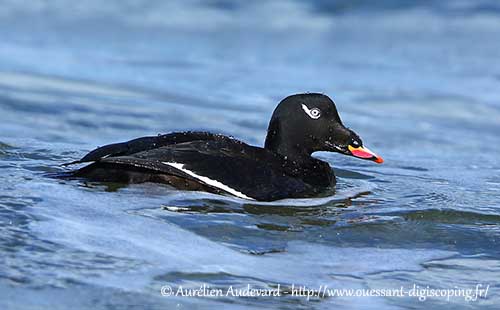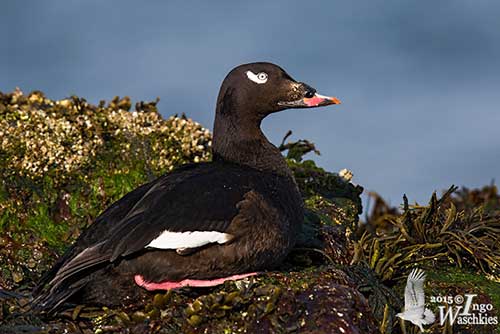
Fr: Macreuse à ailes blanches
Ang: White-winged Scoter
All: Amerikanische Samtente
Esp: Negrón aliblanco
Ita: Orco marino americano
Nd: Pacifische Grote Zee-eend
Sd: Knölsvärta
Photographers:
Aurélien Audevard
OUESSANT DIGISCOPING
Ken Havard
My Bird Gallery & Flickr gallery 1 & Flickr gallery 2
Ingo Waschkies
My bird pictures on Pbase
Text by Nicole Bouglouan
Sources:
HANDBOOK OF THE BIRDS OF THE WORLD vol 1 by Josep del Hoyo-Andrew Elliot-Jordi Sargatal - Lynx Edicions - ISBN: 8487334105
GUIDE DES CANARDS, DES OIES ET DES CYGNES – de Steve Madge - Delachaux et Niestlé - ISBN: 2603013769
What Bird-The ultimate Bird Guide (Mitchell Waite)
Bird Web (Seattle Audubon Society)
Wikipedia, the free encyclopaedia
White-winged Scoter
Melanitta deglandi
Anseriformes Order – Anatidae Family
INTRODUCTION:
The White-winged Scoter was formerly a subspecies of the Velvet Scoter (M. fusca), but following recent studies, it is now considered a full species. It differs from the two other species, the Surf Scoter and the Common Scoter, by the large, white speculum on the black wings which is absent in both species.
The White-winged Scoter is a North American species that breeds in Alaska and Canada, and winters along both E and W coasts of N America, including Aleutian Islands.
It occurs in marine waters during winter, but during the breeding season, it is found in freshwater ponds in the open boreal forest.
The White-winged Scoter is threatened by changes in its habitat, hunting pressure and oil spills especially during winter in estuaries and bays. The population trend is decreasing.

The adult female is mostly dark brown. On the head, she has pale greyish-brown patches between eyes and bill and adjacent to ear-coverts (not always visible). The bill is dark grey or black, with less prominent knob at base. The eyes are brown. Legs and feet are dull reddish.
The juvenile resembles female with paler breast and whiter and larger pale head markings. The young male is usually dull brown to black, with variable black mottling on the upperparts. The adult plumage appears in second autumn.
RANGE:
The White-winged Scoter breeds in Alaska and Canada, E to Hudson Bay. It winters along both W and E coasts of North America, along the W coast from W Aleutian Islands, S to Baja California, and along E coast from Gulf of St Lawrence, S to N Florida. They occur sometimes along the Gulf Coast and on large reservoirs, lakes and rivers in southern USA.
HABITAT:
The White-winged Scoter breeds around lakes, ponds and slow-moving rivers in boreal forest and Arctic tundra, and occasionally well inland.
It winters mainly at sea in shallow coastal waters, usually over shellfish beds. Some birds may remain on great lakes and large bodies of freshwater.
The juveniles often spend the first year at sea.
CALLS AND SONGS: SOUNDS BY XENO-CANTO
The White-winged Scoter is usually fairly silent. However, it becomes more vocal during the breeding season, with males giving double-whistled calls “whur-er” or “fee-er” and guttural croaks. The female produces a thin whistle.
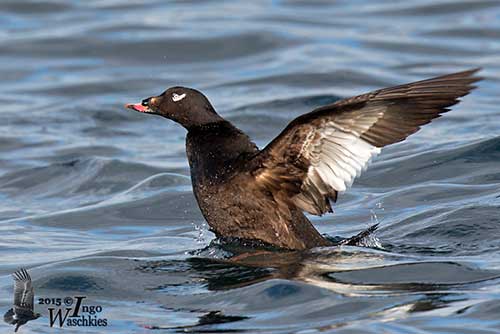
BEHAVIOUR IN THE WILD:
The White-winged Scoter feeds primarily on molluscs, but it also consumes crustaceans, worms, echinoderms, annelids and small fish. In fresh water, it takes insects and their larvae.
It occasionally eats some plant material such as sea lettuce, pondweeds and others in addition to aquatic insects.
While foraging, it dives and swims underwater. It propels itself with the webbed feet, but the semi-open wings also aid in manoeuvring. It usually swallows the small preys immediately underwater, whereas the larger preys (molluscs) are swallowed whole at the surface. Molluscs are collected from mussel beds at depths of 5-12 metres.
The White-winged Scoter is gregarious and occurs in large flocks outside breeding season and for roosting. Pairs usually form in late winter and spring, before to reach the breeding grounds.
Courtship displays typically involve several males around one female. The displaying males lower the head and arch the back before rushing forwards over short distance on water surface. The female is often pursued by several males on short underwater chases. Prior to copulation, the paired birds perform preening and false drinking. They are monogamous.
The male leaves the female during the incubation and reaches other waterbodies for moulting with the non-breeding birds. Females and young join them later.
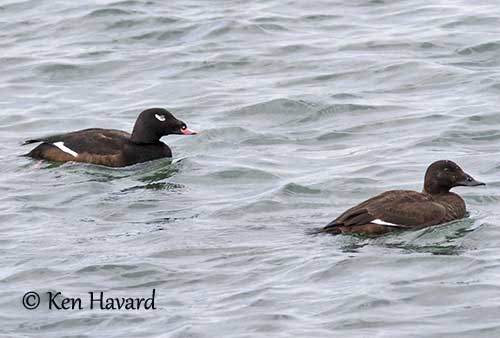
The White-winged Scoter is migratory. It leaves the breeding grounds in September, and reaches the wintering areas along both Pacific and Atlantic North American coasts. They usually fly in flocks of up to 300 birds, following large lakes and rivers on their way to the coasts.
The flocks fly usually low over the sea surface, forming long, wavering lines. However, in migration, they often fly much higher, but sometimes, they suddenly drop with a loud rushing noise.
The White-winged Scoter’s flight is heavier than that of other scoters. It has to run more over water before to take-off. The flight is direct with steady, quick wingbeats.
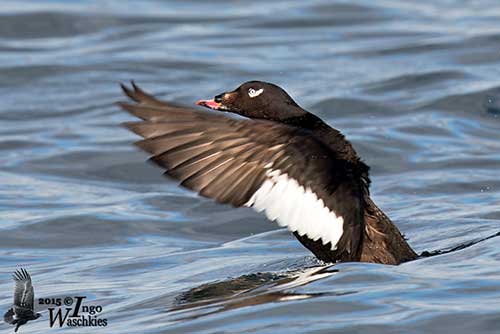
PROTECTION / THREATS / STATUS:
The White-winged Scoter is vulnerable to oil-spills and marine pollutants while moulting and wintering along sea coasts. It is threatened by fishing nets and habitat degradation in taiga and lower tundra regions in the breeding range. It is also affected by disturbance in both coastal and freshwater habitats and by hunting pressure.
The population has not been quantified, and any reliable estimate of the White-winged Scoter’s population is available as the results are mixed from combined subspecies.
But currently, The White-winged Scoter is evaluated as Least Concern.
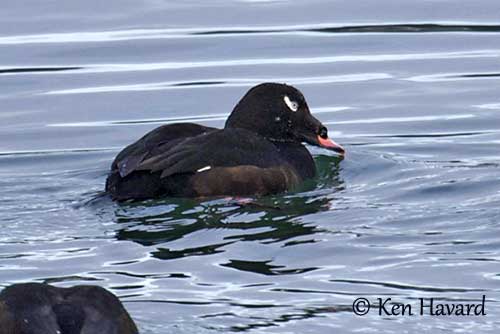
REPRODUCTION OF THIS SPECIES:
The breeding season starts in May-June, but the laying often occurs until late June/early May.
The White-winged Scoter nests on the ground among dense vegetation. The pair defends a small territory around the nest-site. It may nest solitary or in loose groups, especially on islands. In boreal forest and taiga country, it sometimes nests close to Laridae colonies.
The nest is a shallow depression with sparse lining of pieces of vegetation found in the surrounding, and the female adds some down. It is usually placed between 100 metres and 2-3 kilometres from open water.
The female lays 5-17 creamy-buff to pale yellowish eggs (9 in average). She incubates during 25-30 days, starting when the last egg is laid.
At hatching, the downy chicks are brooded for the first day. Then, they walk to water and swim to reach the brood-rearing areas. The chicks feed themselves and avoid predators by diving. They are brooded and protected by the female during 1-3 weeks. Then, the abandoned young form groups of 15-40, and up to 100 juveniles. They fledge about 60-70 days after hatching. They are sexually mature at 2-3 years.
The nests are attacked by avian and mammalian predators including gulls, coyotes and red foxes.
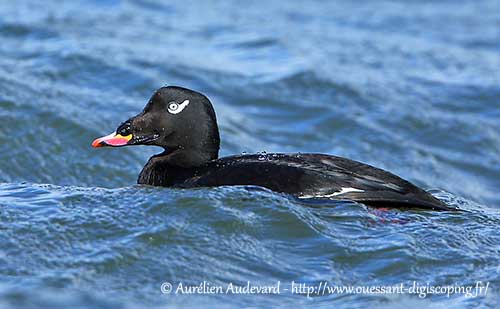
DESCRIPTION OF THE BIRD:
Biometrics:
Length: 51-58 cm
Wingspan: 86-100 cm
Weight: M: 1360-1770 g – F: 955-1400 g
The White-winged Scoter adult male has glossy black plumage with white eye patch. It differs from other scoters by its larger size and the large, white speculum formed by the white secondaries and greater coverts. This square wing patch is not conspicuous on closed wings, but prominent in flight. The underparts appear mostly dark brown.
On the head, the two-tone bill is orange, becoming red at tip. There is a large black knob at base of upper mandible. The eyes are pale grey with narrow white eyering above, and white crescent below the eye, forming an ascendant comma. Legs and webbed feet are reddish pink with blackish webs.
Outside the breeding season, the male is duller with pale-mottled flanks.
